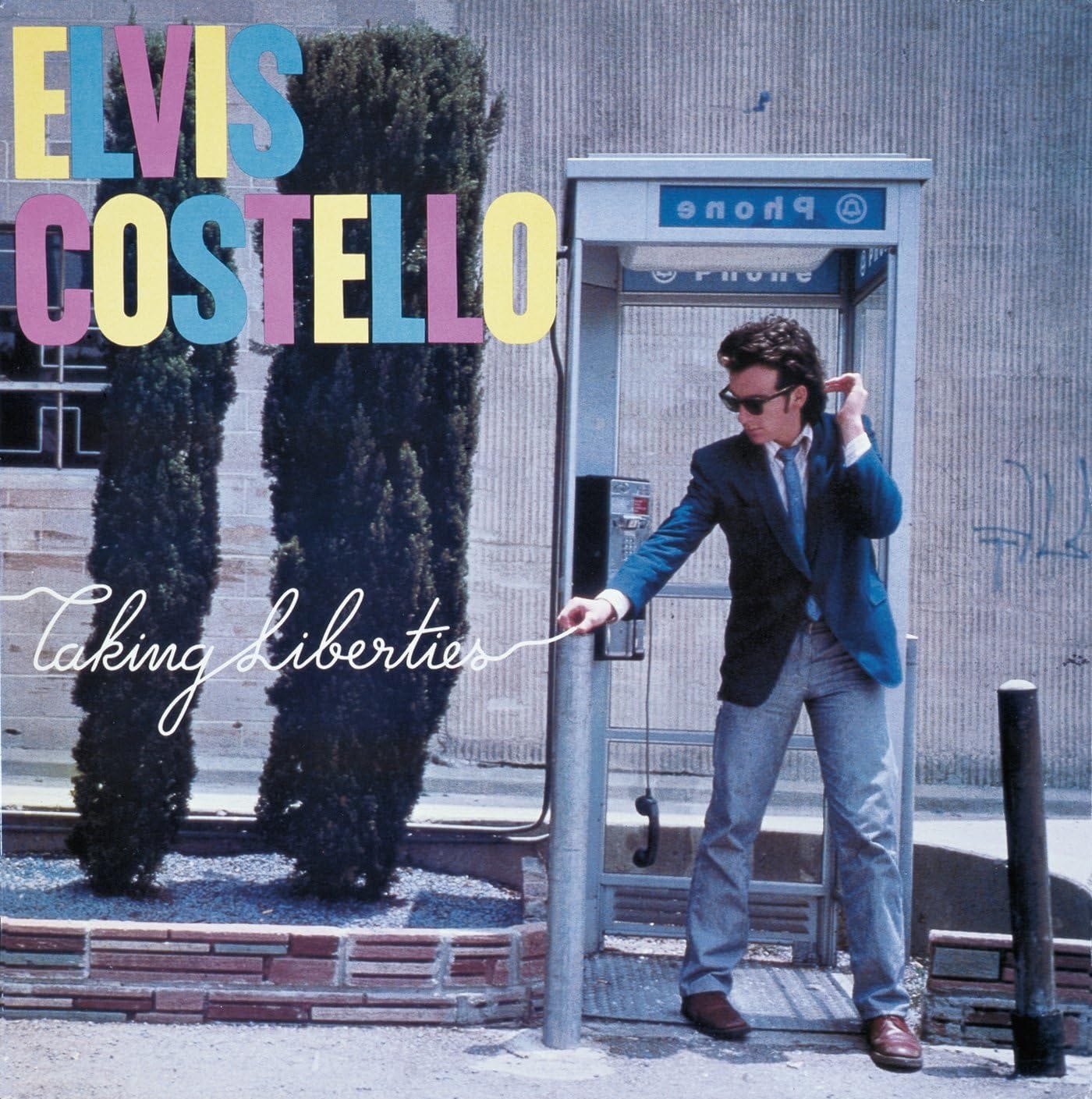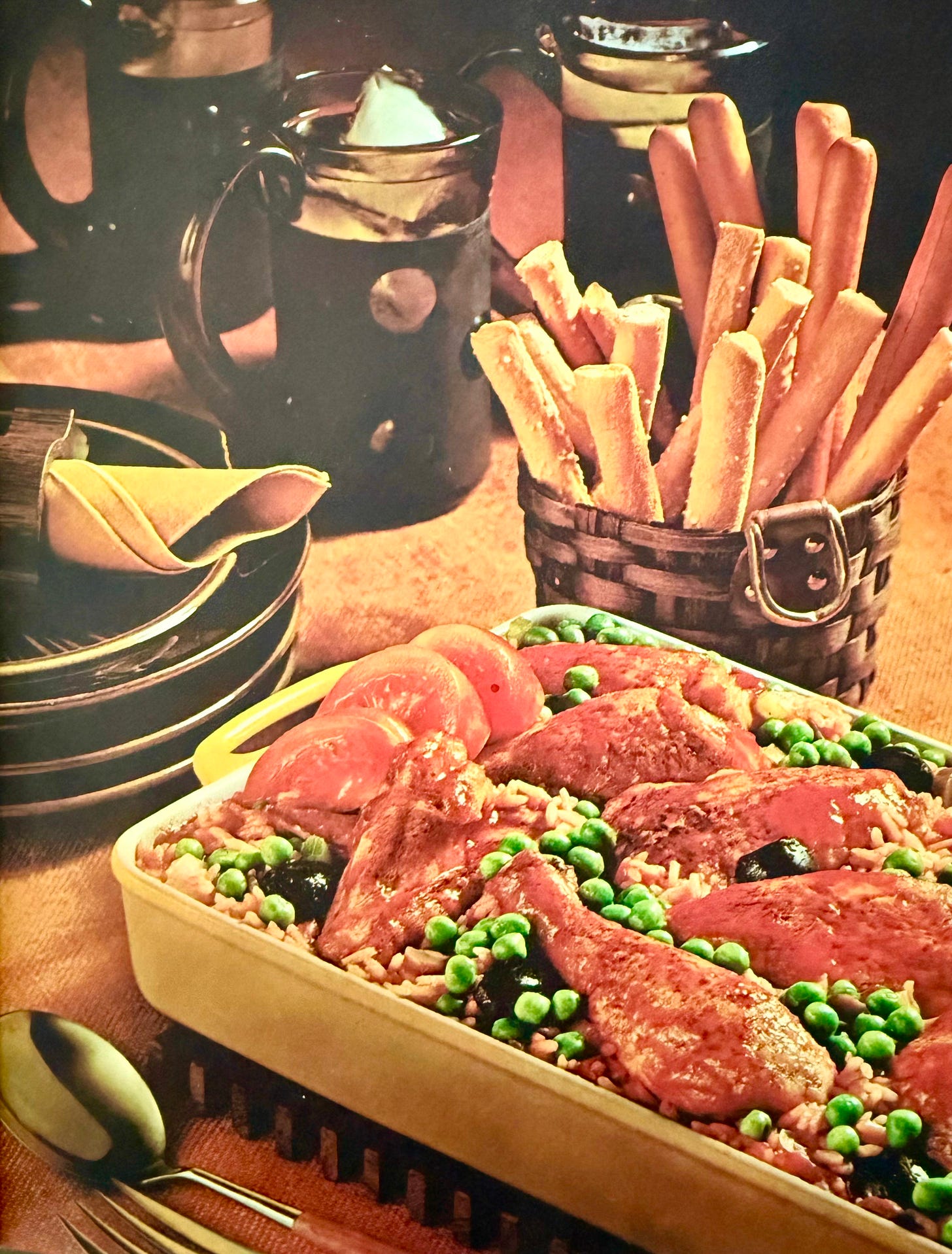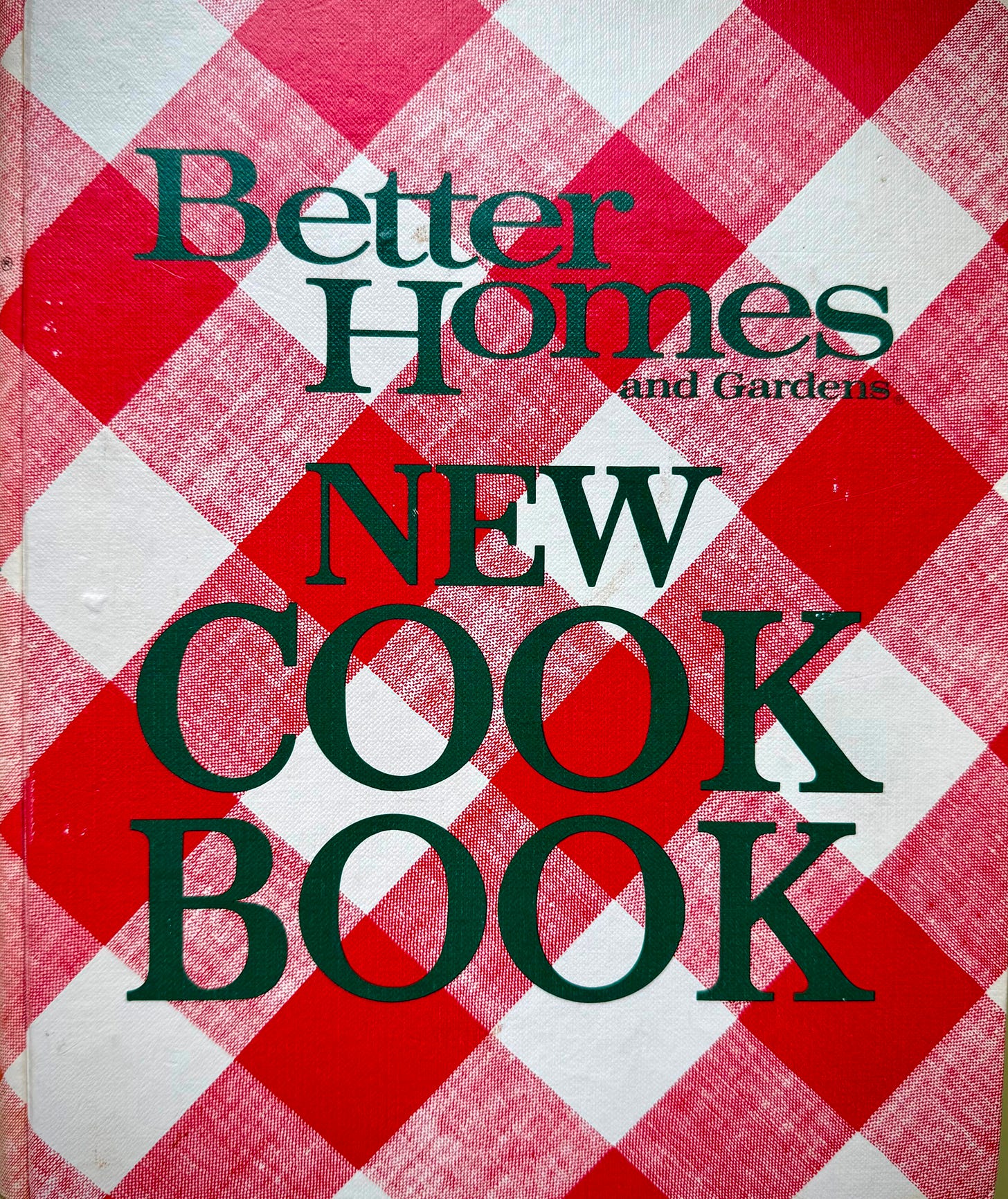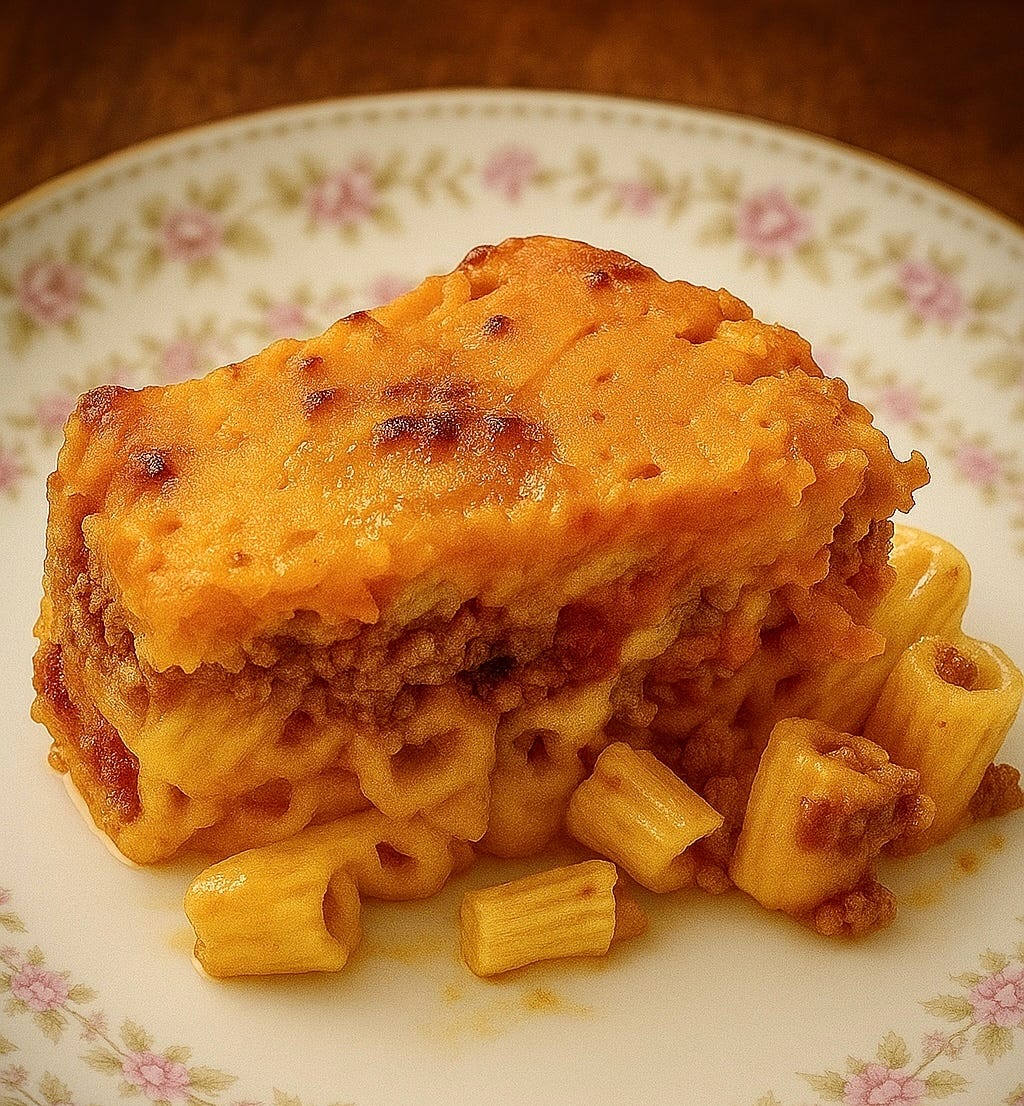Starting from scratch
and a recipe for a lamb and honeynut squash pastitsio to make with your honey
To everyone new here, welcome. I’m Elizabeth, the writer of The Delicious Bits Dispatch, a weekly missive for the curious, blending discovery, reflection, and musings, always wrapped up with a seasonal recipe worth lingering over.
The first time I made dinner for Richard, it was a bit disastrous.
I had just started living on my own, in what Brits might call a glorified bed-sit: a single room plus separate washroom, with a rudimentary electric coil-top stove, an apartment-sized refrigerator and a wash-up alcove that once was a closet.
The furnishings were cast-offs and treasures from home: my grandmother’s solid oak wardrobe; a wood bench that once graced a bank but looked more like a church pew; a table for two in the “kitchen.” In a quirky twist, the room had an electric fireplace that barely emitted heat and a built-in bar—a black and red curved art deco-ish caprice in one corner that was handy for hiding storing things.
There certainly wasn’t enough room to have a proper cocktail party. With my twin bed taking up precious real estate, there was barely space to live. But I did have an outsized poster of Elvis Costello’s Taking Liberties album cover on the wall to declare my loyalties.

Cooking for beginners
I had moved to Toronto with an adventurous palate and a love of food but barely rudimentary cooking skills. It was not for lack of exposure. My Italian mama was an excellent cook, with a repertoire of no-recipe-required comfort foods she made to perfection: gnocchi, homemade pasta, lasagne, musetto e polenta, the world’s best minestrone.
With the insouciance and live-in-the-moment arrogance of youth, I didn’t bother to learn even the basics, although I was always an extra pair of hands during frequent gnocchi- and pasta-making sessions, and for the annual rituals of baking panettone and making plum jam and tomato sauce.
If observation alone can make a novice an expert, I should have been one by the age of 12. Instead, I ventured into my first cooking adventures armed only with the classic Better Homes and Gardens New Cook Book—a gift from my sister Lucia—plus an indelible imprint in my cortex of what really good food tasted like.
In what would become a lifelong passion, I also began buying my own cookbooks—but not the Italian classics I should have started with: Marcella Hazan, Ada Boni, Anna del Conte. Instead, I accumulated vintage Better Homes and Gardens titles: Favorite Ways with Chicken; Holiday Cookbook; Snacks and Refreshments.
Hardly the starter library for an Italian girl learning to cook.
Two peas in a pod
Back to that first home-cooked meal for Richard.
Those early meals and first dates were not of the usual “getting to know you” variety. We went from first date to marriage in 231 days, a relationship built on an existing friendship and the alchemy of opposites attracting. Fine-tuning preferences, likes, dislikes, annoyances, charms, is the work of a lifetime and one wayward meal would hardly create a ripple.
Still, I wanted to impress. I had mastered a couple of recipes from Favorite Ways with Chicken and Chicken and Saffron Rice seemed just about right.

When I produced the dish from the oven with a flourish, I didn’t know that Richard detested peas. Nor would I find out until well after we were married. In the kindhearted and empathetic way that is his defining trait, Richard ate every bite, complimenting the budding chef and choking down those peas without a grimace.
One of the very nicest things about life is the way we must regularly stop whatever it is we are doing and devote our attention to eating.
—Luciano Pavarotti
As Pavarotti wisely observed, pausing and devoting our attention to eating is one of life’s nicest moments. In our kitchen, that pause often starts with the two of us making meals together.
Over the years, and through three kitchens, my cooking skills have grown considerably, as have his. Where once I needed to be the sole proprietor in the kitchen, time and space have allowed us room to cook side by side—and have finally taught me patience enough to do it in meditative harmony.
Yesterday found us in our galley kitchen, still working out the ballet that a new space choreographs, starting from scratch yet again. Our recipes of choice rotate frequently: Richard might choose a flavourful soup or stew to carry us through the week; I might be trying yet again to perfect my sourdough or make some easy-serve meals for the daughter of a friend who’s a new mom. The blaring music gives a hint as to whose selection it is—although Richard is as much a fan of Elvis Costello these days as I am of Dvořák. And thankfully he also likes peas now too.
Yet there is much that remains the same. I have three burners on the go, while Richard is methodically chopping all the ingredients he needs for his mise en place. Old roles die hard; our days without a dishwasher are well-etched into us, and Richard still takes on much of the intermittent washing up that an afternoon of cooking produces.
The moment the dance is learned, as effortless as an Astaire-Rogers waltz, never announces itself. Only in the final glorious moment of sitting down to eat does our attention fully come into focus.
If you enjoy these missives—and I hope you do—tap the heart ❤️, share, or comment to help new readers find their way to this newsletter
Lamb and honeynut squash pastitsio
adapted from Ellen Kornmehl, Eating and Feeding
makes 1 9x9 casserole
While I can make a lasagna that my mother would be proud of, more often than not a layered casserole dish is something I leave to a “company’s coming” moment. But when my friend Ellen posted a photo of a butternut squash pastitsio she had made, I was intrigued.
Traditional pastitsio is a layered Greek baked pasta made with long hollow noodles, a spiced beef-and-tomato layer, with a thick, egg-enriched béchamel poured over the top. Ellen’s version takes its cues from the classic and heads in a lighter, more modern direction. Instead of the usual beef-and-tomato base, it leans on ground lamb with a broader, more assertive spice profile and subs out roasted squash for the topping, which brings both sweetness and depth.
I took the flavouring a step further, amping the Middle Eastern vibe with the addition of both sweet and hot smoked paprika. I increased the amount of lamb, and decreased the pasta and squash. Even the béchamel is reimagined. I followed Ellen’s lead by eliminating the cheese and also ditched the egg. The result is a pastitsio that feels familiar yet decidedly lighter, cozier, and perfect for a weekend cook-together.
Note: Honeynut squash takes everything we love about butternut and turns up the volume: deeper colour, sweeter flesh, and a lush, velvety texture. It also cooks more quickly. If you can’t find it, butternut squash is a great substitute.
Ingredients
1½ pounds ground lamb
2½ pounds honeynut or butternut squash (see Note)
9 ounces tubetti rigati or elbow macaroni
1 medium onion, coarsely chopped
1 398 ml/14 oz can cherry or diced tomatoes
1 garlic clove, finely minced
1 teaspoon thyme
1 teaspoon oregano
1 bay leaf
1 teaspoon ground cumin
½ teaspoon cinnamon
½ teaspoon Aleppo pepper
1 teaspoon smoked sweet paprika
1 teaspoon smoked hot paprika
4 tablespoons extra-virgin olive oil
¼ cup flat-leaf parsley, minced
1 cup beef or chicken broth
1 teaspoon kosher salt
a few grinds of freshly ground black pepper
Béchamel Sauce
2 tablespoons butter
1 small onion, finely chopped
2 tablespoons flour
½ teaspoon salt
2 cups 2% milk
Heat the oven to 425 F. Brush a 9×9 baking dish with a thin layer of olive oil and set aside.
Peel and cube the squash. Toss the cubes in 1 tablespoon of olive oil and spread on a rimmed baking tray. Roast in the oven 25 minutes or until fork tender and easily pierced. Remove from the oven and allow to cool.
Reduce the oven temperature to 375 F. Mix together the cumin, cinnamon, Aleppo pepper, smoked sweet paprika, smoked hot paprika and a pinch of salt in a small bowl.
Set a deep skillet on the stove and heat the remaining 2 tablespoons olive oil over medium heat. Add the onion and sauté, stirring frequently, about 15 minutes until golden. Create a well in the centre of the onions and add the spices, cooking for about 30 seconds until aromatic, and then add the garlic, stirring together with the spices and the onions until combined well.
Add the lamb, canned tomatoes, 1 teaspoon salt, bay leaf, thyme, oregano, parsley and black pepper. Sauté, breaking up clumps, 8 minutes or until the meat is no longer pink. Remove about a tablespoon of excess fat, leaving some residual. Continue to cook until the lamb is browned and the tomatoes have broken down, oozing their juices, about 10 minutes more. Add the broth, cover tightly, and continue to simmer 20 minutes on low heat, stirring occasionally.
While the meat is cooking, set a large pot of water to boil and salt until the water tastes like the sea. Cook the pasta until al dente (follow package guidance but always taste! Al dente means the pasta is tender but still offers a slight, pleasant resistance in the centre.) Drain and remove the pasta immediately to a large bowl and toss the pasta in 1 tablespoon olive oil.
Using an immersion blender or food processor, puree honeynut squash until smooth. Set aside.
Make the béchamel
Warm the milk in a saucepan over low heat.
In a large saucepan, melt butter over medium heat. Add chopped onions and gently sauté for 5 minutes or until softened.
Whisk in the flour and continue whisking with the butter and onions until smooth, about 1 minute.
Slowly whisk in the warm milk, a little at a time, until fully incorporated and the bechamel is smooth. Add the salt and nutmeg. Simmer, whisking occasionally, until thickened and glossy.
Assemble the pastitsio
Add ½ cup of the lamb mixture and 1 cup of the béchamel to the pasta and mix to combine. Spoon the pasta mixture into the prepared dish and use the back of a spoon to gently press and level it.
Add the rest of the lamb mixture as the next layer, spreading the mixture to the edges of the dish.
Add the remaining béchamel to the pureed squash and stir to blend well. Layer the squash mixture over the meat layer, again using the back of a spoon to spread the squash layer to the dish edges.
Bake 35 minutes in the oven, uncovered, or until bubbly and the edges begin to brown. Allow to rest 10 minutes and serve.
To read Ellen’s original post and recipe, click below. She does an excellent deep dive in the potato, and suggests why this widely used vegetable may be problematic in your diet. Think squash instead!






Elvis Costello!!!! 🙌
I think we learn so much just by watching our parents or grandparents cook. By the way, your piece took me back to my tiny studio apartment in Oxford.